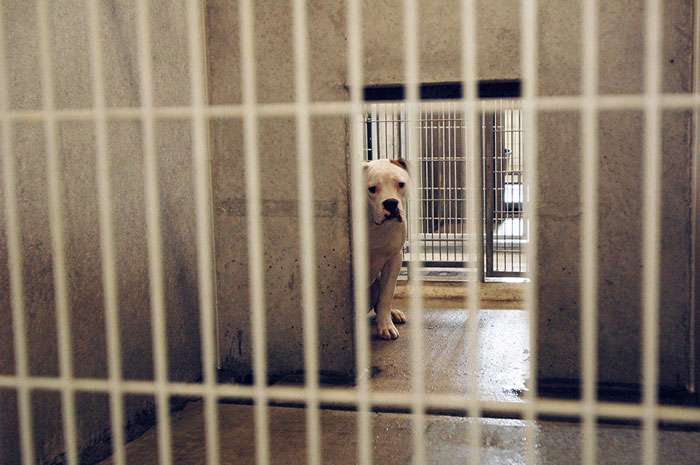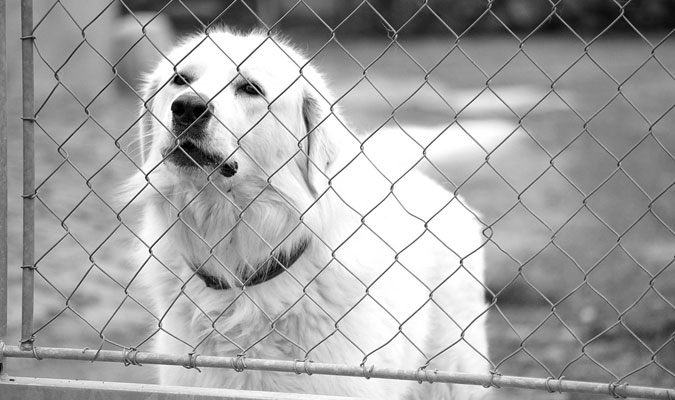In the February issue, which will be in mailboxes and online soon, we have an article about a new model for communities looking to improve the practices and policies adopted by their local animal shelters and rescue groups. The new model has been called “Socially Conscious Sheltering” (SCS) and we are fans of its basic concepts. The article was written by WDJ’s Training Editor Pat Miller, who has more than 40 years of experience working in and closely with animal shelters.
The article not only explains what SCS is, but also offers a brief history of animal sheltering in this country, from the height of the “bad old days” – around 1970, when tens of millions of unwanted animals were killed in shelters annually – to the advent of the “no-kill shelter” and its rise in popularity, and past that to where we are now.
Is a “no kill” policy better?
There is no doubt that no-kill policies have inspired innovative programs and increased community support, resulting in many animals’ lives saved. But many people feel that the no-kill model needs updating – that it has inadvertently created problems that need to be addressed.
For example, you may or may not be aware that “no kill” policies are blamed by many animal training and behavior experts for a relative increase (relative to the actual animal population) in the rate of injuries and even fatalities caused by dangerous dogs. Critics say that far too many dogs with the propensity for violence are being “rescued” and adopted to unprepared and unsuspecting people, who unwittingly put the dogs in situations where they are almost bound to hurt someone. Note that it’s not just no-kill shelters and rescues that are under pressure to increase their “live release” rates; the bar has been raised for all shelters and rescues – which is a good thing, but can also lead to irresponsible adoptions.
No-kill policies have led to an astounding number of “rescue hoarding” cases, wherein a person or group of people, usually starting out with good intentions, loses control of their situation and ends up housing far more animals than they can care for. We are seeing reports of these cases nearly daily in the news – and in almost every case, the animals who end up needing “rescue” again are in far worse situations than they were in when initially “rescued” by the overwhelmed person or group of people: starved, sick, warehoused in crowded conditions, living in filth. Without city, county, or state oversight, and often without the oversight of a proper nonprofit Board of Directors, some of these operate until there is a literal stench that alerts a neighbor and drives an investigation. (Go ahead, run the words “dog rescue hoarder” through your favorite search engine. It’s insane how many cases there are.)

There are also persistent accusations that some animal rescue or shelter groups engage in all sorts of unethical practices in order to protect and promote their “no kill” status. According to the official Asilomar Accords definition of “no kill,” only shelters or rescue groups that kill less then 10% of the animals they take in – excluding the animals who are brought to the shelter by owners who request that the animal is euthanized – may call themselves a “no-kill.”
As just one example of how organizations may engage in morally questionable activities in pursuit or maintenance of their “no-kill” status, one animal-welfare blog has accused the Animal Care Centers of New York of pressuring people who have come to the shelter to relinquish their pets to “request” euthanasia so that those animals may be euthanized without adding to the total of animals that might be euthanized for space or health or behavior problems.
There have also been persistent allegations that when shelters limit the number of animals that they will take in, often in service of preventing the “need” to euthanize “for space,” that the “dumping” of animals in those communities increases.
What’s the difference between “no kill” and “socially conscious” sheltering?
Socially Conscious Sheltering principles were developed by a group of animal shelter CEOs in Colorado, and refined through sharing and discussion among a select group of animal shelter and animal welfare experts. The founders hope that the principles are widely adopted for a post- “no-kill” society, where all healthy (and treatable) and adoptable animals who do not pose a danger to others are maintained in suitable environments until adopted, and where dangerous dogs are not foisted into unsuspecting communities.
It’s sad, but the reality is that there are dogs who cannot live safely with other animals or people. It’s hard for me to understand, but there are also plenty of people who will fight for the lives of dogs who have mauled, or even killed, innocent humans or other animals. In this story, a rescue group placed a Saint Bernard in a family, and about five weeks later, the dog mauled a five-year-old boy in the family. There was a 12-year-old and a 7-year-old boy home at the time of the incident, but no adult. The dog was seized by local animal control authorities, who indicated that the dog would likely be euthanized, as per their SCS principles that state, “Because public safety is a top priority, we work diligently to ensure dangerous animals are kept from harming other animals and people.” But the rescue group that “saved” and later placed the dog has filed a lawsuit and is seeking donations in support of regaining custody of the dog. The group’s Facebook page has hundreds of comments in support of this effort.
The family in this case was pretty clearly ignorant of proper supervision and handling of this dog. It also looks like a pretty negligent adoption, frankly! But the fact remains that the dog mauled a child. Should the dog be returned to the rescue group who placed him the first time? Or should he be euthanized? It’s a case that divides dog lovers as ferociously as any red state/blue state debate.
The SCS model says, let’s put our resources where they will benefit the most healthy and treatable (behaviorally and biologically) animals. Also, let’s make public all of every shelter’s statistics regarding intake and outcomes, so that anyone can judge how well or poorly the shelter is faring in its mission, without an arbitrary target number that qualifies it as worthy of support or shame.
For much more detailed information about Socially Conscious Sheltering, see the February issue of WDJ.







Our local shelter, the Potter League in Middletown, RI, is NOT a non-kill shelter (or it doesn’t advertise the fact), but it does work hard with dogs and is fairly good at placements. We don’t have a lot of strays or turn-ins here, so a lot of our dogs come up from “high kill” shelters in the south. I work for my vet, so I see a lot of these “rescues” and some who come straight from the “rescue” organization probably should have been vetted better in both health and behavioral issues. I totally agree that not all aggressive dogs can be, or should be saved. It’s not fair to either the animal or an unsuspecting, uneducated owner. BTW, our shelter has trained behavioral staff as well as an excellent obedience training set of instructors, and all adoptees get free basic training classes, which is almost more for the owner than the dog!
To be honest I think it’s a conversation that needs to be had. There are far too many dangerous dogs that are adopted out into unsuspecting homes and homes that are not equipped to handle aggression.
I don’t mean behavior problems, or anxiety problems. I’m talking about truly aggressive animals. We have the mindset that all animals deserve a second, third, fourth chance and that it’s “all in how you raise them” (which is complete bs)
We place our own emotions and thoughts on the dogs, when they couldn’t care less about our emotions and personal opinions. Dogs live for the moment, they don’t have life goals, they don’t have future plans. If today is good, that’s all that matters to them. When all of the today’s become a time of turmoil. When all today’s are just pain and separation. When all today’s are stress. When all of the today’s are spent managing. What are we forcing them to live for? They can’t do most of the things a dog should be able to, they can’t enjoy all of the things we wish they could.
These aren’t dogs just having a bad time. This is their life. Something is wrong. There are dogs that have shown the ability to attack, maul, and kill and yet we force them to live through whatever demons they are carrying mentally. We think we can fix everything, but some things can’t be fixed, Genetics can’t be altered, they can’t be fixed. We can’t rewire a dogs brain to think, react, and be what we want it to be.
Sometimes the most merciful thing we can do for an animal is to set it free and if people can’t even conceive that as a concept then people need to really consider what responsible pet ownership is all about.
It is so hard to value humility these days – and yet it is the virtue most needed everywhere, especially by and among people of good will, trying to do, if not the “right” thing, then the best thing they can, given the givens. We have learned that in addition to genetics and environment, there is epigenetics. In addition to what one person can do with the resources they have under the constraints they cannot change, there is the temptation to generalize, saying that what they could not do, no one could do.
We are learning so much by trying, pushing the boundaries, advocating and risking much for long-shots. We vehemently reject the attribution of blame to dogs, yet somehow we can’t let go of the idea that innocence requires denial of obvious facts. We still feel that euthanasia is punishment, and if a dog is innocent, he can’t be “punished.”
Is it not possible to accept our own personal and societal failures as facts? We do have obligations to dogs because we have made them what they are. But we have to be able to accept our failure to make over particular dogs. Accept them as our failures, accept whatever degree of blame is appropriate, and also acknowledge that warehousing a dog we can’t make whole, or adopting him into a situation where he’ll hurt someone are both courses of action that compound our failure. Keep learning how to cure dogs mental and emotional diseases and applying new knowledge, taking the risks upon ourselves – yes. But acknowledge failure, suffer and mourn the necessary action, and keep doing our best.
Well put, sister!
Beautifully written and infinitely wise. Thank you.
I adopted my last two dogs from shelters. I had rather strict criteria for choosing a dog to adopt. My son has severe autism and is extremely sensitive to barking and noise. But I had to tell the staff I was looking for a calm, adult dog; no one asked questions, just said to “look at the dogs and see if any interested me”. I think too many people adopt a dog only based on looks, with no idea of a dog’s temperament, behavior, activity level and exercise needs. The dog is then blamed for failing to adjust to their family’s lifestyle. Adopters need to be honest about what they want in a dog, and shelters need to not adopt out dogs that are clearly not suited for a particular family.
I agree that we need to more carefully check out these “no kill” shelters. I volunteer at a “no kill” shelter, and the director LOVES pit bulls. Therefore, her goal in life is to “save” every pit bull and pit mix she can find. To that end, she spends her days searching kill shelters for pits who are scheduled for euthenization and sends somebody to pick them up. The shelter is overrun with pits. And some of them, not because they’re pits, but because of their histories, breeding, etc, are not the best rescues. I am reminded of a case where a pit was returned several times for aggressive behavior. To my knowledge, he had never been exposed to cats, and the staff had no reason to suspect that he didn’t like cats. That adopter didn’t inform the staff that he had a cat, but the dog killed the family cat, and he was returned. Another family adopted him, and within a few weeks, he had attacked his owner while he sat reading the newspaper, requiring plastic surgery to repair his mauled face. That dog was euthanized, but it took many months and many returns for the director to make the decision. The fact that almost every adoptable dog we have is a pit or pit mix makes local people look at other shelters to rescue a small dog or one that fits their needs.
Closing no-kill shelters can’t happen soon enough. Twenty-five years ago it was common to let your dog meet the other dogs you encountered on your walks. Now people cross the street to avoid the risk of the encounter. Dogs in shelters that present a threat to other dogs, let alone people, should be euthanized, period.
And we need to stop bringing in dogs from other countries–often of questionable health and behavior backgrounds–so that “rescues” and “shelters” can sell them.
(Mary Jamison: No-kill shelters didn’t create the problem you describe. Ignorant and irresponsible owners did)
Some rescues are taking dogs from SPCA’s that are on the line to be euthanized BECAUSE they have behavior problems and are not adoptable. Then they adopt these dogs out to families and the family is not aware of the dog’s past or the issues that the dog has, the dog then attacks a family member, and the rescue, who says they will take dogs back, does not reply to any messages or phone calls from this family and does not take the dog back. If the dog is deemed to have dangerous type behavior issues then it is irresponsible to even send it to another rescue in the first place. There are situations where a dog does need to be euthanized. Of course the dog should have a thorough temperment evaluation first and the decision should not be taken lightly, but sometimes these decisions need to be made. There are also a lot of owners that want to surrender their dogs to a rescue because the dog has dangerous type behavior issues, it is also irresponsible of these people to send the dog anywhere and push the problem off on someone else, and it is irresponsible of a rescue to take a dog with known issues like this (providing the owner is honest and even tells them the truth about the dog). I am all for doing whatever you can to help a dog but there are times when euthanization is the only responsible thing to do.
People think “no-kill” shelters are wonderful, but as everyone has mentioned, they have issues. It’s terrible when a shelter adopts out an aggressive animal because they don’t want to euthanize, but it’s also not fair that they call shelters that euthanize “kill” shelters, and yet pass off their unadoptables to “kill” shelters to be euthanized anyway.
I worked as an adoption advisor at a shelter for several years, and we euthanized aggressive animals or animals that were unadoptable for some other reason. We evaluated all animals that came in and sent many to foster care for training, socializing, etc. We did what we could, but as some of you have already said, sometimes it gets to a point where we realize the animal can’t be rehabilitated, and the hard decision has to be made. I love what Laurie Raymond said: “Acknowledge failure, suffer and mourn the necessary action, and keep doing our best.” That’s exactly what our shelter did.
I remember when I first started working there, a friend asked if I worked at a no-kill shelter. When I said, no, we euthanize unadoptable animals, she said, “Really? If I’d known that I wouldn’t have donated to them!” I told her that no-kill shelters are not necessarily reducing euthanasia. I said, “Let’s say a no-kill shelter has 100 dog kennels, and they’re all full. What do you think happens when owner #101 brings in their dog? They tell the person they have no room and to take their dog to us. What if a dog is aggressive? They tell the owner they won’t take aggressive dogs and send them to us. No-kill shelters are not saving more animals; they’re just passing the buck to the shelters who are willing to make the heartbreaking decision to euthanize when an animal is unadoptable.” I’ve explained this to many people over the years. Pretty much every time the other person says something like, “Wow, I never thought of it that way.”
So please don’t ever refer to shelters that euthanize as “kill” shelters. They don’t “kill” animals, EVER. They euthanize, which is humane, painless, loving, and respectful. When I worked at the shelter, we petted the animal and made them as comfortable as possible. We tried to set our feelings aside to be able to do what was right and necessary, but sometimes we cried. These types of shelters are not heartless because they euthanize. They just do what the “no-kill” shelters aren’t willing to do; euthanize when it’s necessary. When I worked there, we always referred to ourselves as “open admission” because we would take any animal that was brought to us regardless of their adoptability. We called “no-kill” shelters “closed admissions” because they only accepted adoptable animals. (Although I’ve learned here today that some of them try to adopt out the unadoptables – unbelievable!) Please consider using these terms in the future, or at the very least, call them “shelters that euthanize.” People don’t work at shelters to make money (obviously!), they work there because they love animals. Yes, even the people that work at shelters that euthanize love animals. Thanks for listening.
I worked for several years as the canine supervisor for our local shelter. We did our best to work with every dog, but we ended up deciding to euthanize some that we did not feel were safe to place or had behavior problems that we didn’t have the resources to solve. It was often a difficult decision because you knew that, with the right adopter, in the right setting, with the right training, the dog could probably be successful. But what were the chances of that adopter coming in our doors, who could safely manage the situation for the rest of the dog’s life? And what if management failed in one instance, as it often does? Many negative repercussions: the dog being euthanized anyway, a person or other animal being injured or killed, the adopters being traumatized, other people being put off from adopting a “shelter dog” because they’re all “broken.” I comforted dogs as they were put to sleep. It really makes you analyze what you believe about death and find a way to have peace about it.
Besides putting dangerous dogs into a community, other factors need consideration. One is sheer numbers of dogs saved. If we have 10 kennels and 2 of them are occupied for 6 months or a year by dogs who are not safe or extremely hard to place, that’s 2 kennels that are not available to house adoptable dogs. If the average stay for adoptable dogs is 2 weeks, then in 6 months that’s 24 dogs (or in a year, 48) who could have occupied those two kennels and gone home with someone. Those same adoptable dogs may have instead been euthanized for lack of space in a busy shelter during that time.
Another issue with literal “no kill” is dogs who live for months or years or their whole life in a kennel by themselves. They do not live normal dog lives for a social species. They may have a few kennel staff that will spend time and play with them. But that only amounts to a small percentage of each day. Many dogs go “kennel crazy” from the isolation, and those that don’t live lonely, long hours by themselves for years. To me, this is a fate worse than death. Being alive is not the same as having a life.
I used to think we could and should “save them all.” I no longer think we can, or should. I think we should admit our failures–everything from poor breeding, to ignorant care, to inhumane treatment, to our throwaway society–try to fix those human social problems, and in the meantime do the best we can for the greatest number. And sometimes that is going to mean sacrificing the few for the good of the many.
Great article I must stress.
The idea behind both the shelter and adoption is to give these canine creatures a better life. However, it requires a whole lot of planning and background checks.
Intending pet parents are not meant to carry out the process void of an idea of the kind of dog they want, well as the attitudinal tendencies of the dog to be adopted.
In the real sense, every dog has a home.
What isn’t clear in the example story (St Bernard mauls 5-year-old) is whether or not the 5-year-old did something to the St Bernard to provoke the attack. Given there were no adults home at the time, it is not known for sure one way or the other. Young children like to try to ‘ride’ large dogs, etc. In fact, WDJ once posted an article criticizing a couple for allowing (encouraging, actually) a toddler to pretty much abuse the family dog by pulling on its ears, crushing the dog with its body, etc.; the warning being that it was dog abuse and the child was in danger of being hurt–badly. So, if the dog was provoked, is it really fair to put it down? If it wasn’t provoked and it is truly dangerous, then yes. But, I believe in this particular case, the dog should be given a second chance and perhaps placed in a home with no young children or other dogs as the shelter is requesting.
Very good article. I see a huge issue with untrained dogs who are humanized and coddled like infants or worse, left alone in a yard all day and night. The owners are unaware of the well meant but huge disservice they do to their beloved pet. And then when the dog does develop a serious behavior problem their owners send then to a shelter. Having said that, my belief (backed by considerable research) is that the overwhelming number of these dogs are entirely capable of being well trained without bad behaviors including aggression. Some few aren’t and euthanasia is the kindest most humane option. The key is the training- balanced, behaviorally based, 99 % positive, a lot of hard work and YES, using a “no” and corrections when dealing with an unwanted behavior. I think shelters and rescues could be a lot more upfront about what is involved in rehabilitating a dog including implying that obedience training only will make problem behaviors go away. I live with two rottweilers-both from rescues and really the joy of my life! Lots of hard work to deal with fear based reactivity and many thanks to folks like Jeff Gillman and his great compassion towards people and their dogs. Anyway, lots of good people out there who love dogs and want the multi faceted complex shelter issues resolved-together we can find a solution.